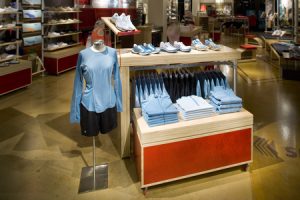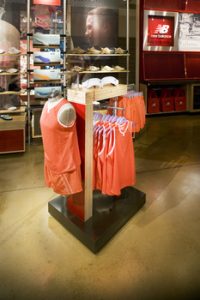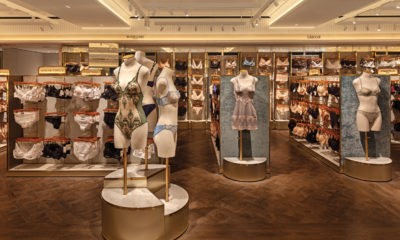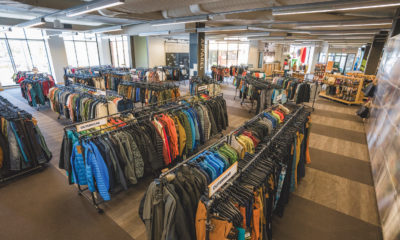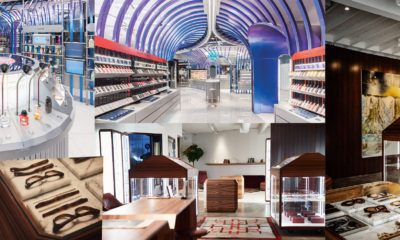It was a chicken’s foot that first inspired New Balance founder William Riley in 1906 to build arch supports for people who were constantly on their feet. The chicken’s three claws created a balance, which translated into an arch design that afforded more comfort and a better fit.
Nineteen years later, Riley designed his first running shoe. And it caught on. By 1941, New Balance was making custom shoes for baseball, basketball, tennis and boxing.
With the introduction of the Trackster in 1960, the first running shoe available in multiple widths, New Balance had formed its niche within the athletic shoe arena.
But that history, evolution and authenticity of product wasn’t coming across in the stores, according to Eric Daniel, prototype director for WD Partners (Dublin, Ohio). “New Balance invests an incredible amount of resources into product research and development,” he says. “They needed to share that with their customers. So that story became our main design focus.”
That research takes precedence down the center of the store in the form of “tester profiles” – everyday athletes given New Balance shoes and asked to keep a diary of their experiences, making notes on how the shoes felt, how they performed, how they wear.
Each profile features a large-format graphic of the tester in action with biographical information, the tested shoe’s style number at the top (New Balance uses a numbering system instead of naming different shoe models) and a booklet of their findings affixed to a shelf.
“We wanted to put the most current, relevant New Balance story at shoppers’ fingertips,” says Daniel. “So the area where customers try on shoes is positioned around the tester profiles.”
Within the 3600-square-foot Mashpee store, designers grouped merchandise presentations – women’s running, men’s fitness, women’s trail. Simple nesting tables, t-stands and two-way fixtures that double as four-ways facilitate storytelling among the collections.
“This design is about welcoming and connecting with our consumers,” says Kirsten Marchand, New Balance’s store planning manager. “Merchandising by category and gender has increased product exposure and allows us to celebrate the technology that goes into our footwear, apparel and accessories.”
Historical images and the original patent drawing are pictured behind the cashwrap. The statement significant to the company’s history, “the original shoe for running,” is inscribed in the concrete flooring.
In addition, adds Marchand, “It’s important for us to work on lowering our environmental impact, and it’s a continual and evolving process.” Numerous updates have been made from past store iterations, including specifying EcoX, a U.S.-based 70 percent post-consumer and post-industrial recycled concrete surface from Meld USA, for the cashwrap and Dakota Burl slatwall, a composite material made out of sunflower seed husks, for the store’s perimeter. Designers also installed low-voltage lighting, and graphics are printed on recycled chipboard.
“We added a distressed texture to the graphics so it became very apparent that it was printed on recycled material,” Daniel says. “It’s another way, without putting up a banner or fanfare, to let customers see that New Balance is environmentally conscious.”
Client: New Balance, Boston
Design: WD Partners, Dublin, Ohio
Architect: Forth Architectural Services, Sandwich, Mass.
Fixtures: Wisconsin Built, Deerfield, Wis.; EPS Specialties Ltd. Inc., Cincinnati
Carpet: Interface, Atlanta
Lighting: Western Extralite Co., Kansas City, Mo.
Forms: Ronis Brothers, Lynbrook, N.Y.
Furniture: Davis Furniture Industries Inc., High Point, N.C.
Signage/Graphics: P+R Group, Chicago
Paint: Benjamin Moore, Montvale, N.J.
Concrete Stain: L.M. Scofield Co., Los Angeles
Photography: Mark Steele Photography, Columbus, Ohio
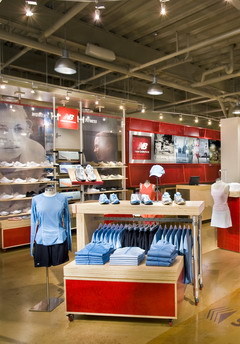

 Photo Gallery1 week ago
Photo Gallery1 week ago
 Headlines2 days ago
Headlines2 days ago
 Headlines1 week ago
Headlines1 week ago
 Headlines1 week ago
Headlines1 week ago
 Designer Dozen2 weeks ago
Designer Dozen2 weeks ago
 Headlines1 week ago
Headlines1 week ago
 Designer Dozen6 days ago
Designer Dozen6 days ago
 Headlines1 week ago
Headlines1 week ago

